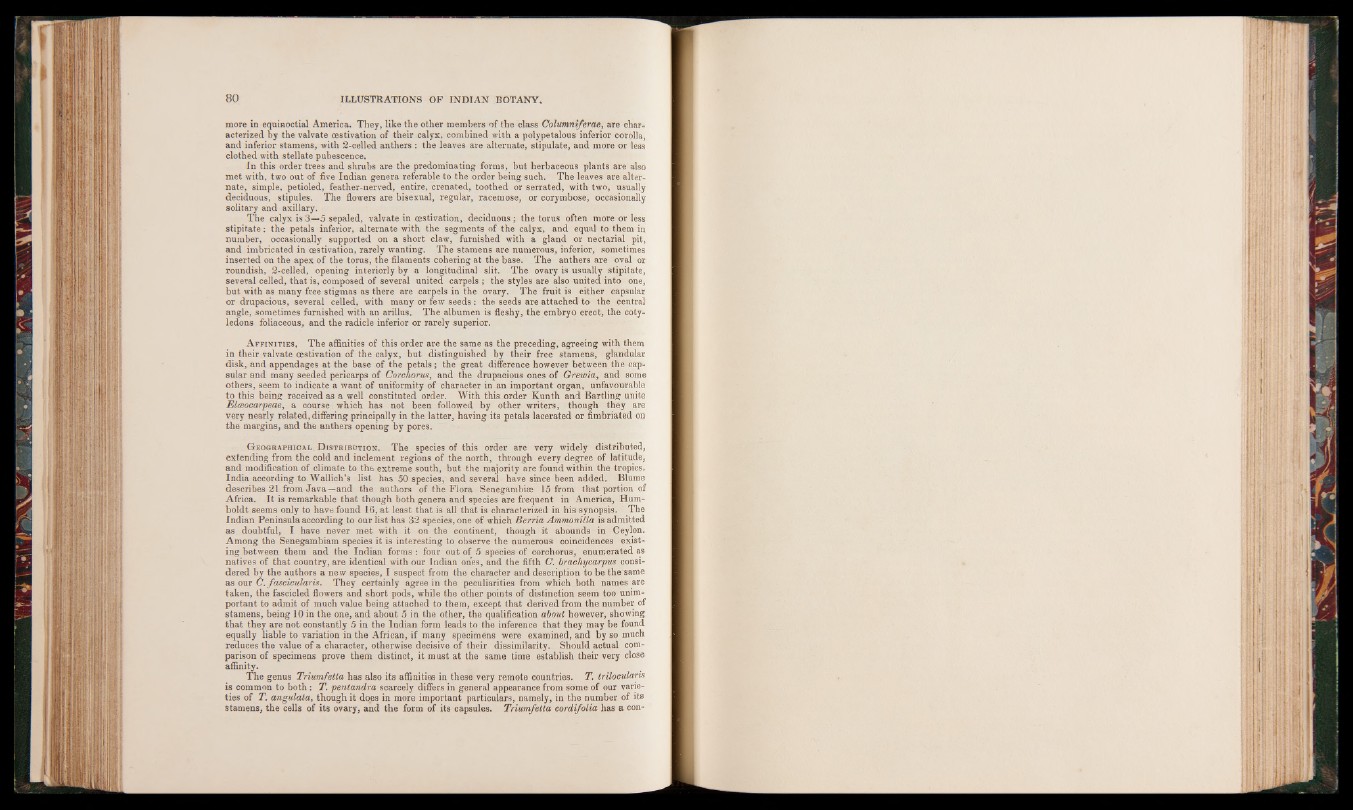
more in equinoctial America. They, like the other members of the class Columniferae, are characterized
by the valvate (estivation of their calyx, combined with a polypetalous inferior corolla,
and inferior stamens, with 2-celled anthers : the leaves are alternate, stipulate, and more or less
clothed with stellate pubescence.
In this order trees and shrubs are the predominating forms, but herbaceous plants are also
met with, two out of five Indian genera referable to the order being such. The leaves are alternate,
simple, petioled, feather-nerved, entire, crenated, toothed or serrated, with two, usually
deciduous, stipules. The flowers are bisexual, regular, racemose, or corymbose, occasionally
solitary and axillary.
The calyx is 3—5 sepaled, valvate in oestivation, deciduous; the torus often more or less
stipitate: the petals inferior, alternate with the segments of the calyx, and equal to them in
number, occasionally supported on a short claw, furnished with a gland or nectarial pit,
and imbricated in oestivation, rarely wanting. The stamens are numerous, inferior, sometimes
inserted on the apex of the torus, the filaments cohering at the base. The anthers are oval or
roundish, 2-celled, opening interiorly by a longitudinal slit. The ovary is usually stipitate,
several celled, that is, composed of several united carpels ; the styles are also united into one,
but with as many free stigmas as there are carpels in the ovary. The fruit is either capsular
or drupacious, several celled, with many or few seeds: the seeds are attached to the central
angle, sometimes furnished with an arillus. The albumen is fleshy, the embryo erect, the cotyledons
foliaceous, and the radicle inferior or rarely superior.
A f f in it ie s , The affinities of this order are the same as the preceding, agreeing with them
in their valvate cestivation of the calyx, but distinguished by their free stamens, glandular
disk, and appendages at the base of the petals; the great difference however between the capsular
and many seeded pericarps of Corchorus, and the drupacious ones of Grewia, and some
others, seem to indicate a want of uniformity of character in an important organ, unfavourable
to this being received as a well constituted order. With this order Kunth and Bartling unite
Elceocarpeae, a course which has not been followed by other writers, though they are
very nearly related, differing principally in the latter, having its petals lacerated or fimbriated on
the margins, and the anthers opening by pores.
G eographical D istr ibu t ion. The species of this order are very widely distributed,
extending from the cold and inclement regions of the north, through every degree of latitude,
and modification of climate to the extreme south, but the majority are found within the tropics.
India according to Wallich’s list has 50 species, and several have since been added. Blume
describes 21 from Java—and the authors of the Flora Senegambiae 15 from that portion of
Africa. It is remarkable that though both genera and species are frequent in America, Humboldt
seems only to have found 16, at least that is all that is characterized in his synopsis. The
Indian Peninsula according to our list has 32 species, one of which Berria Ammonilla is admitted
as doubtful, I have never met with it on the continent, though it abounds in Ceylon.
Among the Senegambiam species it is interesting to observe the numerous coincidences existing
between them and the Indian forms: four out of 5 species of corchorus, enumerated as
natives of that country, are identical with our Indian ones, and the fifth C. brachycarpus considered
by the authors a new species, I suspect from the character and description to be the same
as our C. fascicularis. They certainly agree in the peculiarities from which both names are
taken, the fascicled flowers and short pods, while the other points of distinction seem too unimportant
to admit of much value being attached to them, except that derived from the number of
stamens, being 10 in the one, and about 5 in the other, the qualification about however, showing
that they are not constantly 5 in the Indian form leads to the inference that they may be found
equally liable to variation in the African, if many specimens were examined, and by so much
reduces the value of a character, otherwise decisive of their dissimilarity. Should actual comparison
of specimens prove them distinct, it must at the same time establish their very close
affinity.
The genus Triumfetta has also its affinities in these very remote countries. T. triloculans
is common to both : T. pentandra scarcely differs in general appearance from some of our varieties
of T. angulata, though it does in more important particulars, namely, in the number of its
stamens, the cells of its ovary, and the form of its capsules. Triumfetta cordifolia has a con